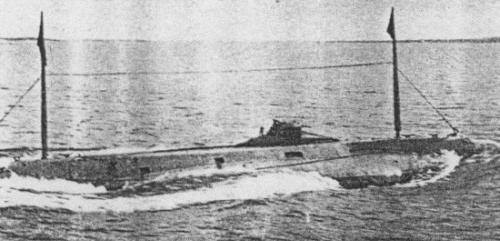

Holland 1900
|
No |
Name |
Yard No |
Builder |
Laid down |
Launched |
Comm |
Fate |
|
SS1 |
Holland |
35 |
Crescent, Elizabethport |
11/1896 |
3/1897 |
10.1900 |
stricken 11.1910 |
|
Displacement standard, t |
|
|
Displacement normal, t |
64 / 74 |
|
Length, m |
16.4 |
|
Breadth, m |
3.10 |
|
Draught, m |
2.60 |
|
No of shafts |
1 |
|
Machinery |
1 Otto petrol engine / 1 electric motor |
|
Power, h. p. |
45 / 50 |
|
Max speed, kts |
8 / 5 |
|
Fuel, t |
petrol 3.6 |
|
Endurance, nm(kts) |
|
|
Armament |
1 x 1 - 203/40 pneumatic gun, 1 - 450 TT (bow, 3) |
|
Complement |
7 |
|
Diving depth operational, m |
25 |
Project history: The first modern US submarine, she was also the direct progenitor of modern British and Japanese craft, combining an internal combustion engine (for surface propulsion) with depth control by hydroplane. That is, in contrast to earlier submarines, this one dived with her ballast tanks full, reducing her to neutral or only slightly positive buoyancy. Her stern planes drove her underwater, and kept her down. Earlier submarine designers used partial flooding to dive and also to adjust the angle of dive; as a result, their submarines were unstable underwater, due to free surface effects in the tanks. Another characteristic feature of the Holland submarine was her very limited surface performance, due in part to her lack of reserve buoyancy: it was optimized for underwater performance. John P. Holland built his first experimental craft in 1878, and in 1895 won a Navy competition with a design for a steam-powered submarine that was ordered as the USS Plunger, However, he believed that steam would never be suitable, and abandoned construction of the craft in favour of the gasoline engine-powered Holland, using his own funds. She was purchased by the Navy on 11 April 1900, and commissioned on 12 October. Some accounts claim that there were originally two pneumatic 'dynamite guns', but contemporary cross-sections show only one.
Holland's main American competitor was Simon Lake, who originally developed submarines primarily for underwater (sea-bottom) exploration. Unlike Holland's, his submarines were designed to dive on an even keel, and most of them had external wheels for motion along the seabed. Lake's supporters charged that their product had been rejected unfairly, and Congress for a time forced the Navy to purchase competitive Lake designs.
Modernizations: None.
Naval service: Holland served at the Naval Academy, Annapolis, in a training role until 17 July 1905.

Holland 1900
© Ivan Gogin, 2014